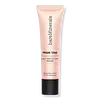What's inside
What's inside
 Key Ingredients
Key Ingredients

 Benefits
Benefits

 Concerns
Concerns

 Ingredients Side-by-side
Ingredients Side-by-side

Titanium Dioxide
Cosmetic ColorantZinc Oxide
Cosmetic ColorantWater
Skin ConditioningCaprylic/Capric Triglyceride
MaskingCoco-Caprylate/Caprate
EmollientUndecane
EmollientPolyglyceryl-6 Polyricinoleate
EmulsifyingTapioca Starch
Glycerin
HumectantTridecane
PerfumingMagnesium Sulfate
Polyglyceryl-2 Isostearate
EmulsifyingTocopherol
AntioxidantHydrogenated Vegetable Oil
EmollientCamellia Japonica Seed Oil
EmollientTheobroma Cacao Extract
Skin ConditioningButylene Glycol
HumectantBisabolol
MaskingBiosaccharide Gum-4
Skin ConditioningAlumina
AbrasiveStearic Acid
CleansingPolyhydroxystearic Acid
EmulsifyingGlyceryl Isostearate
EmollientTriethoxycaprylylsilane
Lecithin
EmollientIsostearic Acid
CleansingPolyglyceryl-3 Polyricinoleate
EmulsifyingDisteardimonium Hectorite
StabilisingIsopropyl Titanium Triisostearate
EmollientPropylene Carbonate
SolventIsononyl Isononanoate
EmollientStearalkonium Hectorite
Gel FormingIsopropyl Myristate
Emollient1,2-Hexanediol
Skin ConditioningCaprylhydroxamic Acid
Propanediol
SolventPhenoxyethanol
PreservativeIron Oxides
Titanium Dioxide, Zinc Oxide, Water, Caprylic/Capric Triglyceride, Coco-Caprylate/Caprate, Undecane, Polyglyceryl-6 Polyricinoleate, Tapioca Starch, Glycerin, Tridecane, Magnesium Sulfate, Polyglyceryl-2 Isostearate, Tocopherol, Hydrogenated Vegetable Oil, Camellia Japonica Seed Oil, Theobroma Cacao Extract, Butylene Glycol, Bisabolol, Biosaccharide Gum-4, Alumina, Stearic Acid, Polyhydroxystearic Acid, Glyceryl Isostearate, Triethoxycaprylylsilane, Lecithin, Isostearic Acid, Polyglyceryl-3 Polyricinoleate, Disteardimonium Hectorite, Isopropyl Titanium Triisostearate, Propylene Carbonate, Isononyl Isononanoate, Stearalkonium Hectorite, Isopropyl Myristate, 1,2-Hexanediol, Caprylhydroxamic Acid, Propanediol, Phenoxyethanol, Iron Oxides
Water
Skin ConditioningCyclopentasiloxane
EmollientGlycerin
HumectantDimethicone
EmollientPEG-10 Dimethicone
Skin ConditioningBis-PEG/PPG-14/14 Dimethicone
EmollientIsododecane
EmollientHydrogenated Starch Hydrolysate
HumectantSodium Chloride
MaskingCaprylic/Capric Triglyceride
MaskingTribehenin
EmollientDimethicone/Polyglycerin-3 Crosspolymer
CleansingPhenoxyethanol
PreservativeCaprylyl Glycol
EmollientMica
Cosmetic ColorantCI 77891
Cosmetic ColorantDisteardimonium Hectorite
StabilisingEthylhexylglycerin
Skin ConditioningEthyl Menthane Carboxamide
TonicPropylene Glycol
HumectantPropylene Carbonate
SolventDipropylene Glycol
HumectantTin Oxide
AbrasiveRosa Gallica Flower Extract
AstringentSorbitol
HumectantCI 19140
Cosmetic ColorantCI 14700
Cosmetic ColorantTocopherol
AntioxidantWater, Cyclopentasiloxane, Glycerin, Dimethicone, PEG-10 Dimethicone, Bis-PEG/PPG-14/14 Dimethicone, Isododecane, Hydrogenated Starch Hydrolysate, Sodium Chloride, Caprylic/Capric Triglyceride, Tribehenin, Dimethicone/Polyglycerin-3 Crosspolymer, Phenoxyethanol, Caprylyl Glycol, Mica, CI 77891, Disteardimonium Hectorite, Ethylhexylglycerin, Ethyl Menthane Carboxamide, Propylene Glycol, Propylene Carbonate, Dipropylene Glycol, Tin Oxide, Rosa Gallica Flower Extract, Sorbitol, CI 19140, CI 14700, Tocopherol
Ingredients Explained
These ingredients are found in both products.
Ingredients higher up in an ingredient list are typically present in a larger amount.
This ingredient is an emollient, solvent, and texture enhancer. It is considered a skin-softener by helping the skin prevent moisture loss.
It helps thicken a product's formula and makes it easier to spread by dissolving clumping compounds.
Caprylic Triglyceride is made by combining glycerin with coconut oil, forming a clear liquid.
While there is an assumption Caprylic Triglyceride can clog pores due to it being derived from coconut oil, there is no research supporting this.
Learn more about Caprylic/Capric TriglycerideDisteardimonium Hectorite comes from the clay mineral named hectorite. It is used to add thickness to a product.
It can also help stabilize a product by helping to disperse other ingredients.
Hectorite is a rare, white clay mineral.
Learn more about Disteardimonium HectoriteGlycerin is already naturally found in your skin. It helps moisturize and protect your skin.
A study from 2016 found glycerin to be more effective as a humectant than AHAs and hyaluronic acid.
As a humectant, it helps the skin stay hydrated by pulling moisture to your skin. The low molecular weight of glycerin allows it to pull moisture into the deeper layers of your skin.
Hydrated skin improves your skin barrier; Your skin barrier helps protect against irritants and bacteria.
Glycerin has also been found to have antimicrobial and antiviral properties. Due to these properties, glycerin is often used in wound and burn treatments.
In cosmetics, glycerin is usually derived from plants such as soybean or palm. However, it can also be sourced from animals, such as tallow or animal fat.
This ingredient is organic, colorless, odorless, and non-toxic.
Glycerin is the name for this ingredient in American English. British English uses Glycerol/Glycerine.
Learn more about GlycerinPhenoxyethanol is a preservative that has germicide, antimicrobial, and aromatic properties. Studies show that phenoxyethanol can prevent microbial growth. By itself, it has a scent that is similar to that of a rose.
It's often used in formulations along with Caprylyl Glycol to preserve the shelf life of products.
This ingredient is a solvent. It helps dissolve active ingredients and alter the texture of products.
Propylene Carbonate is commonly used in makeup and with clay, such as montmorillonite or bentonite.
Studies show this ingredient to be safe for cosmetics. When it is undiluted, it can cause skin irritation. (It is always diluted in skincare and makeup). This ingredient is water-soluble.
Propylene Carbonate is created from propylene glycol and carbonic acid.
Learn more about Propylene CarbonateTocopherol (also known as Vitamin E) is a common antioxidant used to help protect the skin from free-radicals and strengthen the skin barrier. It's also fat soluble - this means our skin is great at absorbing it.
Vitamin E also helps keep your natural skin lipids healthy. Your lipid skin barrier naturally consists of lipids, ceramides, and fatty acids. Vitamin E offers extra protection for your skin’s lipid barrier, keeping your skin healthy and nourished.
Another benefit is a bit of UV protection. Vitamin E helps reduce the damage caused by UVB rays. (It should not replace your sunscreen). Combining it with Vitamin C can decrease sunburned cells and hyperpigmentation after UV exposure.
You might have noticed Vitamin E + C often paired together. This is because it is great at stabilizing Vitamin C. Using the two together helps increase the effectiveness of both ingredients.
There are often claims that Vitamin E can reduce/prevent scarring, but these claims haven't been confirmed by scientific research.
Learn more about TocopherolWater. It's the most common cosmetic ingredient of all. You'll usually see it at the top of ingredient lists, meaning that it makes up the largest part of the product.
So why is it so popular? Water most often acts as a solvent - this means that it helps dissolve other ingredients into the formulation.
You'll also recognize water as that liquid we all need to stay alive. If you see this, drink a glass of water. Stay hydrated!
Learn more about Water